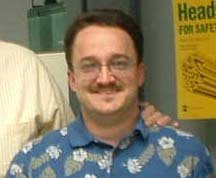I test a LOT of things. Glazes, Clays, engobes, colorants... Lots of things.
In school we made test tiles by throwing an inverted "t" shaped ring and cutting it into tiles. It worked but was slow. At some point I saw an extruder die for making t shaped tiles and decided I had to make one too. I have a drill press and a small XY table so it was a pretty simple thing to make an extruder die out of some Lexan scrap I kept just for that purpose. I use a 3/16" end mill to cut the lexan then add some details here and there with files and other hand tools.

I include a couple of design features that I think are worth mentioning. The top of the tile has one rounded side and one squared side. This can be helpful to test how a glaze reacts to different shapes underneath and in testing glaze fit. One face has a couple of notches that leave raised ridges on the tile to test how the glaze looks on texture. There is also a ridge on both sides of the tile at the bottom of where I dip the tile to test glaze fluidity. If it runs over the ridge, it is really fluid. The vertical part of the tile narrows where it meets the base. This allows you to snap the tile off after firing. I also punch a hole in the unglazed bottom of the tile to allow it to be hung on a glaze bucket if you want. They are easier to store after snapping off the bottom too.
When I extrude these tiles I use an 8 number stamp to stamp the clay id into the wet clay. I keep a notebook and give a code to each clay I test. Other info gets brushed on with red iron oxide and a small brush.
To cut the tiles I made a cutting board with slots spaced evenly and converted a coping saw. I use 7 strand stainless fishing wire from American Fishing Wire to replace the blade. Cuts like a charm. I bought the wire and small crimp cylinders from Cabelas. The coping saw is a woodworking item I had on hand.

I can extrude 10 feet worth of test tiles in 5 minutes. It is extremely fast.

No comments:
Post a Comment